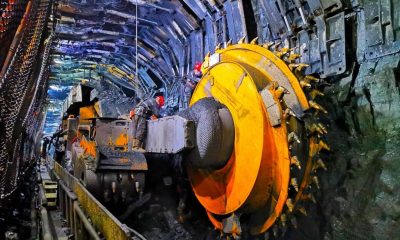Foreign
Henan advances high-quality development through real economy

By Wang Lewen, Fang Min, Bi Jingjin, People’s Daily
In the heart of central China, Henan province has made significant strides toward high-quality development, anchored firmly in the real economy. From major industrial hubs to advanced infrastructure projects, the province’s development momentum is palpable across the central plains.
At a construction site in Luoyang, the second phase of Chinese battery giant CATL’s facility is rapidly taking shape, with tower cranes punctuating the skyline. Meanwhile, in the Zhengzhou Airport Economy Zone, the hum of machinery fills the air as construction activities intensify to establish the Central China Medical Science District.
Henan has prioritized the real economy as the cornerstone of its economic strategy. By leveraging project development as a principal mechanism, the province has actively expanded effective investment and invigoratedthe drivers for stabilizing economic growth.
In 2024, Henan launched 16,800 major projects across various stages of development, encompassing contract signing, groundbreaking ceremonies, and production commencements. Among them, 9,718 projects pertain to advanced manufacturing. Key indicators, including fixed-asset and industrial investment,outpaced the Chinese national average, underscoring the province’s economic momentum.
In Mengzhuang township, Huixian, construction is underway on a smart logistics hub for Chinese e-commerce giant JD.com. Two large warehouses have been completed, the main building has reached structural completion, and other auxiliary facilities are advancing at a steady pace.
With a total investment of over 600 million yuan ($83.32 million), the project encompassessix centers, two bases, and one headquarters. Construction commenced in 2024, with some facilities already operational, generating thousands of jobs.
“We are striking a balance between quick wins and long-term vision,” said Tian Dongfang, director of the township’s economic development office. “Our goal is to build a comprehensive logistics hub for northern Henan, with massive growth potential.”
This equilibrium between short-term accomplishments and forward-lookingplanning underpins Henan’s confidence in its development trajectory. The province maintains a strategicapproach in the formulation and preparation of major projects.
“Henan always keeps a strong pipeline of major projects across key sectors. We maintain a reserve of at least 100 high-quality projects, revising the list every six months based on evolving needs,”explained an official with the Development and Reform Commission of Henan Province.
The province has released its list of key construction projects for 2025, identifying 1,037 provincial-level projects with a combined investment of around 3.1 trillion yuan. It aims to complete investments totaling approximately 1 trillion yuan within the year.
Henan is also capitalizing on its intrinsic advantages to reinforce its development strengths.With a well-establishedindustrial base, the province successfully attracted Chinese automaker SAIC Motor to build a new energy battery plant in Zhengzhou. Concurrently, the province is expediting the development of a 10-billion-yuan food industrial park in Luohe’sYancheng district, harnessing its abundant agricultural resources.
Innovation, infrastructure enhancement, and industrial transformation remain central to Henan’s priorities. The province targets the production of 2 million vehicles in 2025, including 1.4 million new energy vehicles. Meanwhile, it is accelerating construction of major projects such as an ethylene production facility and a fluorosilicon materials complex in Luohe, alongside critical infrastructure projects including the Yellow River Crossing Projectand Phase I project at Zhoukou Central Port.
While expanding itsoverall economic scale, Henan equally emphasizes the qualitative aspects of growth. By upgrading project structures, the province is elevating the standard of industrial development.
At Zhengzhou Hengda Intelligent Control Technology Co., Ltd., a manufacturer specializing in smart control systems for coal mining operations, research personnel now outnumber production workers by a ratio of five to one, resulting in a 67 percent increase in per capita productivity.
The company faced constraints such as limitedgrowth capacity and low automation levels. To facilitate its development, the Zhengzhou Economic and Technological Development Zone designated the construction of a new facility for Hengda Intelligent Control as a key advanced manufacturing project, providing strong policy support and logistical facilitation.
“With more automated and digitalized equipment, we’ve been able to deploy our workforce toward research, development and services,” said Lian Donghui, general manager assistant of the company.
“When planning and executing projects, our primary focus remains industrial development,” said Chen Bo, director of the Henan provincial government’s office for key project construction.
According to Chen, a single major project can serve as a catalyst for new growth, while a cluster of such projects can establish a new economic growth pole. The province actively encourages upstream and downstream businesses to co-locate in proximity to core projects, thereby accelerating cluster-based industrial development.
In Luoyang’sYibin district, a white freight truck loaded with new energy batteries departed the Phase I facility of CATL’s Luoyang base. This flagship project has attracted nine affiliated enterprises along the industrial chain, which have signed agreements to establish operations in the vicinity. As a result, a large-scale new energy battery industrial cluster, with an expected output value of over 100 billion yuan, is rapidly emerging in the city.
High-quality, large-scale projects are providing a firm foundation for Henan’s efforts to stabilize growth, improve its economic structure, and foster new growth drivers. In 2024, the value added of industrial enterprises above the designated size in the province rose 8.1 percent year on year. Fixed-asset investment grew 7 percent, while the value added of strategic emerging industries and high-tech manufacturing increased by 9.2 percent and 12 percent, respectively.
Foreign
China launches Tianwen-2 for asteroid sampling

By Yu Sinan, Li Yi, Zhang Wei
In the early hours of May 29, China successfully launched its first asteroid sample-return mission, Tianwen-2, from the Xichang Satellite Launch Center in southwest China’s Sichuan province, an endeavor designed to shed light on the formation and evolution of asteroids and the early solar system.
The Tianwen-2 mission aims to achieve multiple goals over a decade-long expedition: collecting samples from the near-Earth asteroid 2016HO3 and exploring the main-belt comet 311P, which is more distant than Mars.
The mission includes 13 flight stages and will reach a distance of approximately 150 million to 500 million kilometers from Earth, marking a major step forward in China’s deep space exploration endeavors.
Known as a quasi-satellite of Earth, the asteroid 2016HO3 orbits the Sun and appears to circle around Earth as well, remaining a constant companion to our planet. Its relatively stable orbit requires lower energy requirements for spacecraft to reach it, while enabling a viable scenario for subsequent exploration of the main-belt comet 311P.
Scientific research suggests that the asteroid 2016HO3 may preserve primitive materials from the early solar system. Investigating this asteroid could yield valuable insights into the composition, formation, and evolutionary history of the solar system’s early materials.
The second target, 311P, a celestial anomaly discovered in the mainasteroid belt between Mars and Jupiter, occasionally spews out materials and resembles a comet with tails. While it exhibits compositional traits with traditional comets, it maintains the orbital characteristics of an asteroid. Exploring this unique object will deepen human understanding of the composition, structure, and evolutionary mechanisms of small celestial bodies.
Tianwen-1 marked China’s first Mars exploration mission, successfully achieving orbiting, landing, and roving operations in a single mission. Tianwen-2, however, has a different set of objectives and faces new technical challenges.
First, the Tianwen-2 mission will conduct sampling under weak gravity conditions. Observational data suggest that the asteroid 2016HO3, with an average diameter of about 41 meters, exists in near-zero gravity and rotates rapidly. Given these complex conditions, it is extremely challenging for the probe to achieve stable attachment with the asteroid and sampling within a limited time.
Second, the mission involves vast distances. Asteroid 2016HO3 is located about 18 million to 46 million kilometers from Earth, while the main-belt comet 311P lies approximately 150 million to 500 million kilometers away. The immense distance from Earth imposes stringent requirements on the probe’s communication system, trajectory design, power management, and the capability to maintain highly reliable long-term operational performance.
Furthermore, there is uncertainty regarding the exploration target. Current observations of the asteroid 2016HO3 provide limited information on its rotational behavior and surface characteristics, which significantly complicate the design of both the spacecraft and its sampling methods.
Tianwen-2 is equipped with 11 scientific instruments, including cameras, a visible and infrared imaging spectrometer, a thermal emission spectrometer, and a detection radar, all designed to facilitate scientific data collection during the mission.
In previous missions sending payloads into the Earth’s orbit, a rocket is required to achieve a separation velocity equal to the first cosmic velocity, or approximately 7.9 kilometers per second.
However, this mission requires a separation speed exceeding 11.2 kilometers per second, known as the second cosmic velocity, to escape the Earth’s gravitational influence, necessitating high speed and energy.
After evaluating the rocket’s payload capacity, performance capability, and reliability, Long March-3B was chosen as the dedicated vehicle for the Tianwen-2 mission.
As the primary launch vehicle for China’s high-orbit launches, the Long March-3B has completed 108 missions, including key lunar missions such as Chang’e-3 and Chang’e-4.
Experts noted that asteroids are characterized by their small size, low mass, and weak gravity, making them challenging to capture and requiring exceptional precision in the rocket’s trajectory. During this launch, the rocket reached a speed of 11.2 kilometers per second, with a permitted speed deviation of no more than one meter per second, which could otherwise lead to a positional error of up to one million kilometers.
“Achieving such trajectory precision is akin to shooting a basketball from Shanghai to hit a hoop in Beijing, while ensuring the ball’s angle and speed upon entering the hoop are correct,” said Wei Yuanming, an expert with China Aerospace Science and Technology Corporation.
To tackle this challenge, the rocket design team spent two years completing multiple design iterations so as to achieve seamless “handoff” between the rocket and the probe, Wei added.
Foreign
IOMedadvances international rule of law through innovation, improves global governance

By He Yin, People’s Daily
On May 30, the signing ceremony of the Convention on the Establishment of the International Organization for Mediation (IOMed) was held in Hong Kong. High-level representatives from 85 countries across Asia, Africa, Latin America, and Europe, and nearly 20 international organizations attended the event. Among them, 33 countries signed the convention on-site, making them the founding members of the IOMed.
The establishment of the IOMed marks an innovative step in international rule of law and a major initiative by the Global South to jointly promote global governance reforms and improvements. It has great significance in the history of international relations and fully demonstrates China’s commitment to contributing wisdom and solutions to global development and progress.
The establishment of the IOMed is an actualization of the purposes and principles of the UN Charter. It serves as an important public good in the field of the rule of law for better global governance.
Mediation, as is clearly stated in Article 33 of the UN Charter, is one of the first means that should be tried in seeking peaceful solutions to international disputes. However, prior to theIOMed’screation,no dedicatedintergovernmental legal organization existed to addressinternational disputes through mediation.
The IOMed fills this institutional gap by mediating in disputes between states, between states and investors in other countries, and international commercial disputes at the will of all parties. This represents a significant advancement in the development of the international rule of law.
Drawing upon the strengths of major legal systems, the IOMed respects the autonomy of the parties concerned and offers advantages of being more flexible, cost-effective, convenient, and efficient. It complements and forms synergies with litigation, arbitration, and other existing international dispute settlement mechanisms, thereby enhancing their overall effectiveness.
As the world is entering a new period of turbulence and transformation, the global demand for timely and effective conflict resolution and the need to safeguard long-term cooperative relations is growing stronger.
The proposal to establish the IOMed has received broad international support and active response, reflecting China’s consistent commitment to promoting peace and resolving conflicts on the international stage.
From facilitating the reconciliation between Saudi Arabia and Iran in Beijing, to promoting intra-Palestinian reconciliation talks and the signing of the Beijing Declaration on Ending Division and Strengthening Palestinian National Unity, and to playing a constructive role in promoting the political settlement of the Ukraine crisis, the Palestinian-Israeli conflict, and issues related to the Korean Peninsula and Myanmar, China has long maintained that differences should be handled in the spirit of mutual understanding and accommodation. It advocates building consensus through dialogue and consultation, promoting development through win-win cooperation, and solving problems with a vision for the future, offering Chinese wisdom for countries seeking peaceful solutions to conflicts and differences.
The principles of resolving disputes through dialogue and mediating differencesare universally embraced across civilizations. Chinese civilization, deeply rooted in the value of harmony, has long advocated peaceful coexistence. Its legal tradition values reconciliation and the non-violent conflict resolution,which aligns closely with the principles of modern international law for the peaceful settlement of disputes.
The IOMed does not impose binding rulings but instead provides an impartial platform for voluntary negotiation among parties. It upholds the principles of voluntary participation, equal consultation, and mutual benefit, respects the legitimate concerns of all parties, and strives for win-win outcomes, vividly illustrating the wisdom of harmony and peaceful coexistence.
In the long run, the birth of the IOMed can help transcend the “you-lose-I-win”zero-sum mentality, promote the amicable resolution of international disputes, and foster more harmonious international relations.
The IOMed is a legal public good for improving global governance contributed by countries of the Global South. It will make a significant contribution to upholding international equity and justice.
As the trend toward a multipolar world and greater democracy in international relations gathers momentum, the Global South has transformed from a “silent majority” in international politics to an important force in maintaining peace, driving development, and improving global governance.
Countries from the Global South have actively supported and participated in the establishment of the IOMed, widely recognizing it as consistent with the purposes and principles of the UN Charter and reflective of the values of respect, mutual trust, fairness, and harmony. The IOMed is broadly viewed as an effective measure for strengthening multilateralism.
Looking ahead, the organization will uphold the true spirit of the rule of law, strike a balance between procedural justice and substantive justice, expand the participation of developing countries, and steer international dispute settlement mechanisms toward greater equity and inclusiveness, thereby increasing the representation and voice of the Global South in global governance.
The preamble to the UN Charter solemnly states the commitment “to practice tolerance and live together in peace with one another as good neighbors, and to unite our strength to maintain international peace and security.”This aspiration captures the common vision of the international community.
Looking to the future, as long as all parties make good use of mediation and approach disputes with mutual understanding, they can turn conflict into cooperation, replace confrontation with dialogue, and move forward on the path toward building a community with a shared future for mankind.
Foreign
Outdoor activities fuel new growth in rural China

By Zhou Renjie, People’s Daily
During this year’s May Day holiday, outdoor sports and travel captured wide public interest and participation across China.
At Shijiu Lake in Nanjing, east China’s Jiangsu province, a young visitor transitioned from a fishing lure session tostargazing through a telescope.Nestled in the Aba Tibetan and Qiang autonomous prefecture, southwest China’s Sichuan province, the Siguniang Mountain scenic area launched over 10 outdoor adventure routes, including hiking, mountain trekking, and rockclimbing, catering to outdoor enthusiasts of all ages.
In China, over 400 million people engage in outdoor activities. The development of outdoor sports delivers wide-ranging societalbenefits. It fulfills the growing public demand for physical wellness, advances the Chinese national fitness campaign, stimulates associated industries, and presents vast potential for future development.
A growing number of outdoor sports events and leisure experiences are taking root in scenic destinations across the country.
In Shangri-la, southwest China’s Yunnan province, a network of hiking and cycling trails serves as venues for prominent events such as the Tour of Yunnan International Road Cycling Race and the Yunnan Plateau Lakes and Mountains Series.
In Nanxun, Huzhou, east China’s Zhejiang province, visitors enjoy activities ranging from nocturnal fishing and hot-air ballooning to orienteering through ancient towns.
In Chongli, Zhangjiakou, Hebei province in north China, night skiing enables thrill-seekers to race down snow-covered slopes under a star-filled sky, evoking the sensation of flight just above the earth..
These diverse outdoor experiences act as a powerful engine for transforming picturesque natural environments into sources of sustainable economic development.
China is steadily promoting the development of outdoor sports destinations to ensure the timely achievement of its goal to build around 100 high-quality outdoor sports destinations by 2030. With itsvast territory and spectacular landscapes, the country is well-positioned to leverage its world-class natural resources in this endeavor.
Outdoor tourism development also dovetails with China’s comprehensive rural vitalization strategy. In Xishui county, Huanggang, Hubei province, a rural triathlon combining swimming, road cycling, and cross-country running was held. The event catalyzed economic activity, with online and offline sales of agricultural products exceeding 5.8 million yuan ($807,737), a year-on-year surge of 230 percent.
In the scenic Canglu Valley in Yunnan province’sDali Bai autonomous prefecture,surrounded by lush mountains, a tourism development model centered on outdoor leisure and lifestyles attracted more than 70,000 visitors in 2024, generatingaround 3 million yuan in consumption.
Traditionally, rural areas dense with forests, rivers, and mountains weredeemed economically unsuitable for agricultural or industrial development. Today, many of these regions are leveraging their natural endowments to develop premium outdoor destinations, thereby creating new opportunities for local growth.
High-quality outdoor destinations not only stimulate local cultural and tourism development, but also help expand related industries.
The Chinese outdoor apparel industry, for instance, is experiencing rapid growth. In Zhejiang, a “three-hour supply circle” for manufacturing outdoor jackets has emerged: composite fabrics from Jiaojiang in Taizhou, waterproof zippers from Linhai, fleece liners from Keqiao in Shaoxing, and final assembly in Sanmen. This close-knit supply chain exemplifies how the integration of sports and commerce is accelerating industrial synergy, with supply and demand mutually reinforcing.
In the Guangdong-Hong Kong-Macao Greater Bay Area, novice surfers ride the waves under professional guidance. Along the Yellow River, rally races deliver pulse-pounding excitement. In Hubei province, adigital outdoor sports map is enhancing smart infrastructure and services. What were once niche or fringe activities are now becoming part of everyday life.
By turning “small sports” into “big industries,” and combining proactive government support with dynamic market mechanisms, China is turning innovative concepts into tangible benefits.
-

 Foreign13 hours ago
Foreign13 hours agoXinjiang embraces innovation to modernize agriculture
-

 Foreign6 hours ago
Foreign6 hours agoChina’s trade, auto data highlight bright prospects of Chinese economy
-
Foreign13 hours ago
China’s bearing industry shifts into high gear for high-end development
-

 Foreign6 hours ago
Foreign6 hours agoXinjiang embraces innovation to modernize agriculture
-

 Foreign3 hours ago
Foreign3 hours agoASEAN-China-GCC Summit groundbreaking act of solidarity, self-strengthening for global south
-

 Foreign3 hours ago
Foreign3 hours agoBiodiversity continues to recover in Yangtze river as fishing ban reaches fifth year
-

 Foreign3 hours ago
Foreign3 hours agoWhat makes China ‘cool’
-

 Foreign3 hours ago
Foreign3 hours agoFrom black to green: how Ordos is turning coal lands into a clean energy frontier








